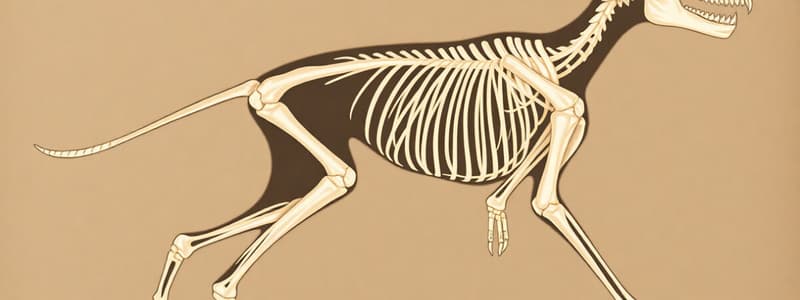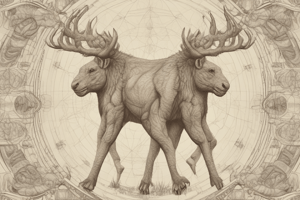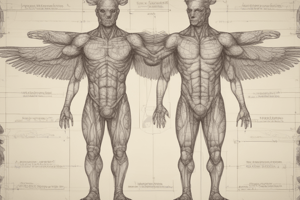Podcast
Questions and Answers
What is cephalisation directly associated with?
What is cephalisation directly associated with?
- Radial symmetry in diploblastic organisms.
- The presence of two gut openings.
- The development of a coelom.
- Bilateral symmetry and concentration of sensory organs in a head region. (correct)
Which of the following describes an animal that possesses three germ layers?
Which of the following describes an animal that possesses three germ layers?
- Triploblastic (correct)
- Asymmetrical
- Acoelomate
- Diploblastic
Which characteristic is exclusive to triploblastic animals?
Which characteristic is exclusive to triploblastic animals?
- Development of a single gut opening.
- Development of mesoderm. (correct)
- Development of ectoderm.
- Development of endoderm.
An animal with one gut opening lacks which of the following?
An animal with one gut opening lacks which of the following?
Which phylum is characterized by asymmetrical body plans, lack of true tissues, and no circulatory system?
Which phylum is characterized by asymmetrical body plans, lack of true tissues, and no circulatory system?
What is the role of the coelom in animal development?
What is the role of the coelom in animal development?
How does the body plan of Porifera and Cnidaria relate to their lifestyle?
How does the body plan of Porifera and Cnidaria relate to their lifestyle?
Why is the absence of a coelom advantageous for organisms like flatworms (Platyhelminthes)?
Why is the absence of a coelom advantageous for organisms like flatworms (Platyhelminthes)?
Which of the following statements accurately compares the circulatory systems of Annelida and Arthropoda?
Which of the following statements accurately compares the circulatory systems of Annelida and Arthropoda?
Consider an invertebrate species crucial for soil aeration and nutrient cycling in an agricultural ecosystem. Removal of this species would most immediately and directly impact what?
Consider an invertebrate species crucial for soil aeration and nutrient cycling in an agricultural ecosystem. Removal of this species would most immediately and directly impact what?
What is a key distinction between diploblastic and triploblastic animals?
What is a key distinction between diploblastic and triploblastic animals?
An animal lacking a coelom is described as:
An animal lacking a coelom is described as:
Which of the following phyla possesses an open circulatory system?
Which of the following phyla possesses an open circulatory system?
What role do invertebrates play that directly enhances soil structure and fertility?
What role do invertebrates play that directly enhances soil structure and fertility?
Which of the following traits is not associated with Porifera (sponges)?
Which of the following traits is not associated with Porifera (sponges)?
In triploblastic animals, which germ layer gives rise to the muscles, connective tissues, and the circulatory system?
In triploblastic animals, which germ layer gives rise to the muscles, connective tissues, and the circulatory system?
Which of the following scenarios would be a direct consequence of widespread decline in invertebrate pollinator populations?
Which of the following scenarios would be a direct consequence of widespread decline in invertebrate pollinator populations?
What evolutionary advantage is most directly related to the development of a coelom?
What evolutionary advantage is most directly related to the development of a coelom?
Which phylum exclusively exhibits radial symmetry, diploblastic organization, and possesses a single opening that functions as both mouth and anus?
Which phylum exclusively exhibits radial symmetry, diploblastic organization, and possesses a single opening that functions as both mouth and anus?
Suppose a novel aquatic invertebrate is discovered exhibiting bilateral symmetry in its larval stage but perfect radial symmetry in its adult form, possesses a complete gut, and demonstrates clear cephalization only during its juvenile phase. Based solely on this information, to which phylum would this organism most likely belong, considering known exceptions and variations within established classifications?
Suppose a novel aquatic invertebrate is discovered exhibiting bilateral symmetry in its larval stage but perfect radial symmetry in its adult form, possesses a complete gut, and demonstrates clear cephalization only during its juvenile phase. Based solely on this information, to which phylum would this organism most likely belong, considering known exceptions and variations within established classifications?
What is the primary distinction between an animal with a coelom and one that is acoelomate?
What is the primary distinction between an animal with a coelom and one that is acoelomate?
Which type of symmetry is LEAST associated with a sessile lifestyle?
Which type of symmetry is LEAST associated with a sessile lifestyle?
What is the primary role of invertebrates such as earthworms in an agricultural ecosystem?
What is the primary role of invertebrates such as earthworms in an agricultural ecosystem?
How does the absence of a circulatory system in Porifera (sponges) and Cnidaria (jellyfish) correlate with their body plan and lifestyle?
How does the absence of a circulatory system in Porifera (sponges) and Cnidaria (jellyfish) correlate with their body plan and lifestyle?
An animal exhibiting bilateral symmetry, triploblastic organization, a coelom, and an open circulatory system would LEAST likely belong to which of the following phyla?
An animal exhibiting bilateral symmetry, triploblastic organization, a coelom, and an open circulatory system would LEAST likely belong to which of the following phyla?
Which of the following animals possesses a digestive system with only one opening?
Which of the following animals possesses a digestive system with only one opening?
Which of the following traits is not a characteristic of animals within the phylum Chordata?
Which of the following traits is not a characteristic of animals within the phylum Chordata?
Predict the most direct consequence of a drastic reduction in the population of invertebrate decomposers, such as earthworms and beetles, within an ecosystem.
Predict the most direct consequence of a drastic reduction in the population of invertebrate decomposers, such as earthworms and beetles, within an ecosystem.
A researcher discovers a new invertebrate species exhibiting bilateral symmetry in the larval stage but radial symmetry as adults, possesses a complete gut, and lacks a circulatory system. This organism most likely belongs to which phylum?
A researcher discovers a new invertebrate species exhibiting bilateral symmetry in the larval stage but radial symmetry as adults, possesses a complete gut, and lacks a circulatory system. This organism most likely belongs to which phylum?
Imagine a scenario where a specific genetic mutation causes a developing triploblastic embryo to fail to form a mesoderm. Assuming the embryo survives to term, which of the following organ systems would be MOST directly affected by this mutation?
Imagine a scenario where a specific genetic mutation causes a developing triploblastic embryo to fail to form a mesoderm. Assuming the embryo survives to term, which of the following organ systems would be MOST directly affected by this mutation?
Flashcards
Cephalisation
Cephalisation
Concentration of sensory organs and nerve tissues in a head region, often associated with bilateral symmetry.
Diploblastic
Diploblastic
Animals with two germ layers: ectoderm and endoderm.
Triploblastic
Triploblastic
Animals with three germ layers: ectoderm, mesoderm, and endoderm.
Coelom
Coelom
Signup and view all the flashcards
Acoelomate
Acoelomate
Signup and view all the flashcards
Porifera (Sponges)
Porifera (Sponges)
Signup and view all the flashcards
Cnidaria (Jellyfish, Corals)
Cnidaria (Jellyfish, Corals)
Signup and view all the flashcards
Chordata
Chordata
Signup and view all the flashcards
Pollination
Pollination
Signup and view all the flashcards
Decomposition
Decomposition
Signup and view all the flashcards
Animal Symmetry
Animal Symmetry
Signup and view all the flashcards
One Gut Opening
One Gut Opening
Signup and view all the flashcards
Two Gut Openings
Two Gut Openings
Signup and view all the flashcards
Annelida (Segmented Worms)
Annelida (Segmented Worms)
Signup and view all the flashcards
Arthropoda
Arthropoda
Signup and view all the flashcards
Body Plan and Mode of Living
Body Plan and Mode of Living
Signup and view all the flashcards
Invertebrate Role in Soil Fertility
Invertebrate Role in Soil Fertility
Signup and view all the flashcards
Soil Aeration by Invertebrates
Soil Aeration by Invertebrates
Signup and view all the flashcards
Acoelomate Structure
Acoelomate Structure
Signup and view all the flashcards
Pollination Importance
Pollination Importance
Signup and view all the flashcards
Soil Aeration Impact
Soil Aeration Impact
Signup and view all the flashcards
Decomposition Benefits
Decomposition Benefits
Signup and view all the flashcards
Study Notes
- Animal body structures exhibit asymmetry, radial symmetry, or bilateral symmetry
- Bilateral symmetry often leads to cephalisation
- Cephalisation involves the concentration of sensory organs and nerve tissues in a head region
- Animals are either diploblastic or triploblastic
- Diploblastic animals have two germ layers: ectoderm and endoderm
- Triploblastic animals have three germ layers: ectoderm, mesoderm, and endoderm
- Germ layers in an embryo differentiate into all the animal’s organs and tissues
- Animals may have one or two openings in their digestive system
- One opening serves as both mouth and anus for some, while others have separate mouth and anus
- A coelom (body cavity) is important for complex organs and systems, including circulatory systems
- The number of tissue layers influences the complexity of organs and tissues
Gut Openings
- Animal digestive systems are categorized based on the number of openings
- Some animals have only one opening, functioning as both mouth and anus
- Other animals have two separate openings: one for ingestion (mouth) and one for excretion (anus)
Animal Phyla
- Animal phyla are distinguished by their body plans
- Porifera (Sponges) are asymmetrical, lack true tissues and gut openings, are acoelomate, and have no circulatory system
- Cnidaria (Jellyfish, Corals) have radial symmetry, are diploblastic, have one gut opening, are acoelomate, and have no circulatory system
- Platyhelminthes (Flatworms) have bilateral symmetry, are triploblastic, have one gut opening, are acoelomate, and have no circulatory system
- Annelida (Segmented Worms) have bilateral symmetry, are triploblastic, have two gut openings, are coelomate, and have a closed circulatory system
- Arthropoda (Insects, Spiders, Crustaceans) have bilateral symmetry, are triploblastic, have two gut openings, are coelomate (haemocoel), and have an open circulatory system
- Chordata (Mammals, Birds, Fish) have bilateral symmetry, are triploblastic, have two gut openings, are coelomate, and have a closed circulatory system
Body Plan and Modes of Living
- An organism’s body plan is closely linked to its mode of living
- The acoelomate structure of Porifera and Cnidaria suits simpler, sessile lifestyles
- The coelomate structure of Chordata supports more complex, active modes of living
Roles of Invertebrates
- Invertebrates include all animals except those in the phylum Chordata
- Invertebrates play essential roles in ecosystems and agriculture
- Insects like bees and butterflies are critical for pollinating many plants, which aids in fruit and seed production
- Invertebrates such as earthworms and beetles decompose organic matter
- Decomposition contributes to soil fertility
- Earthworms and other burrowing invertebrates enhance soil structure and fertility
- Soil aeration improves water retention and penetration
- Decomposition contributes to nutrient cycling
Studying That Suits You
Use AI to generate personalized quizzes and flashcards to suit your learning preferences.




